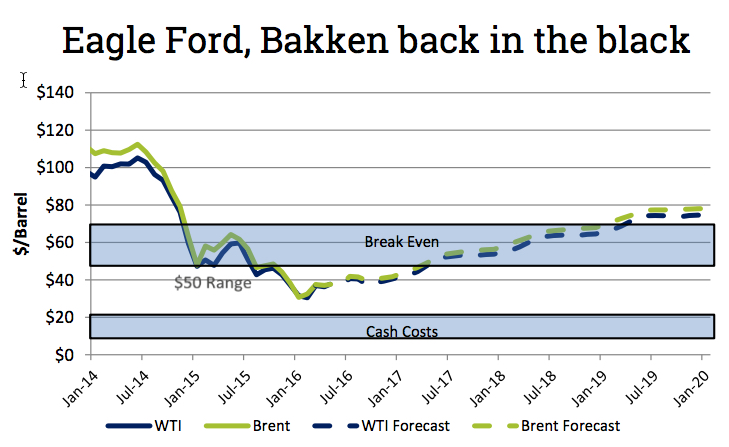
Crude oil prices continued to surprise on Tuesday, with the US benchmark adding another 4% to $44.60 a barrel. West Texas Intermediate is now up 65% since hitting 13-year lows below $27 a barrel February 11. It’s a performance only bettered by the globe’s second most traded bulk commodity – iron ore.
But like analysts of the steelmaking raw material, many in the industry have been surprised by the extent of the rally, consistently calling the oil price lower. The blame for the cloudy outlook for crude is mostly being laid at the door of Saudi-Arabia.
US spare capacity may be close to rivaling OPEC’s current spare capacity
After the collapse of the Doha talks to freeze production and amid a spat with the US over terrorism, the world’s top producer has threatened a scorched earth policy when it comes to maintaining and growing its market share.
But there is an alternative view out there that argues that the US, more than the Saudis, will control the direction of the market and in the event of an all-out price war holds the commanding position.
That’s thanks to astonishing technological improvements in the US. The shale revolution that drove natural gas production between 2010 and 2015, found its way into the oil field, resulting in a 57% jump in US crude production in just three short years to peak at 9.7 million barrels per day in April 2015.

Source: Platts Analytics NG Market Call Long Term, NGL Market Call, and Crude Oil Market Call
And it’s not just a crude story: In the last decade, the US has introduced 8.3 MMBoe/d (million barrels of energy equivalent per day) into the global market when one considers production of crude, natural gas and natural gas liquids according to research by Platts Analytics.
Suzanne Minter, Manager of Oil and Gas Consulting for Platts Analytics on Tuesday testified before the US Senate Energy and Natural Resources Committee about where the global oil market is heading.
Minter said “the time and the rate in which this energy entered the market appears to have stressed the system in ways unimagined” making the US producer “the marginal supplier and price setter into the global market”:
Texas alone could introduce 1.25m barrels into the global market – on average within just 30 days
After 14 months of persistently low prices, U.S. producers have entered 2016 with estimated capital expenditures cuts of 40%, more than 6,500 drilled but uncompleted wells in inventory, and find themselves operating at or near cash costs.
“Drilled but uncompleted wells hold reserves that can be brought on line in a short period of time, thereby defining the concept of spare capacity. It is plausible to believe that U.S. spare capacity may be close to rivaling OPEC’s current spare capacity. However, we believe that the prices needed to incentivize the U.S. producer to complete their drilled but uncompleted wells may be much lower than global competitors believe or would like it to be.
“The near term oil recovery will be more than likely be tenuous and ebb and flow, rather than occur in a linear fashion, as all parties involved figure out how to balance supply growth. However, due to spare capacity and the unique economic environment which drives producer activity, it may very well be that the US producer is best positioned to lead the recovery and bolster economic growth.”
Platts Analytics research shows that Texas alone could introduce 1.25 MMB/d of oil into the global market and can do so in a short space of time – on average just 30 days. That’s more oil than the Saudis have threatened to flood the market with and all very close to the world’s top refining hub.
Over and above resources and technology, the US has another powerful advantage: dynamic markets. The country has roughly 9,000 different entities producing energy. Saudi Arabia’s oil wealth – indeed its whole economy – is now in the hands of a 30-year old prince.
Minter said that “while each producer will behave differently than the next, it seems realistic pricing in the mid-$40 – $50 per barrel range they will bring incremental volumes back into the market place. Well, that’s where we got to today.

Source: Platts/Platts Analytics Oil Market Call April, 2016
[gview file=”http://www.platts.com/IM.Platts.Content/AboutPlatts/MediaCenter/PDF/suzanne-minter-final-testimony-SENR-0416.pdf”]
2 Comments
yourFriend20
Go get em TX!
But one glaring omission remains in this article. The cost to bring all those rigs online and to operate those wells would be in the billions. With 40% budget cuts and most oil companies’ balance sheets in the red or close to it, where are they going to get all that money? The banks? Nope! They’re already overextended in oil. If someone says “oh they can bring that oil online in 30 days” without qualifying at least the funding in this environment, let alone the logistics of rehiring and moving capital, it really doesn’t hold much water.
SnakePlissken
Set the F-ing price at $50 and leave it there forever, so that consumers can plan their industries and personal lives accordingly. That would require brains, I suppose, so, that’s not going to happen.